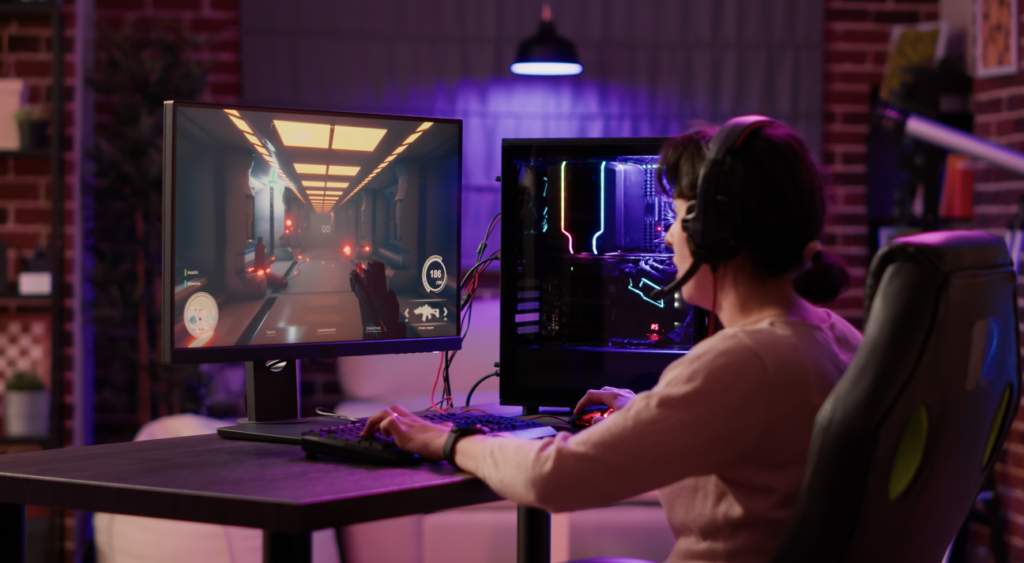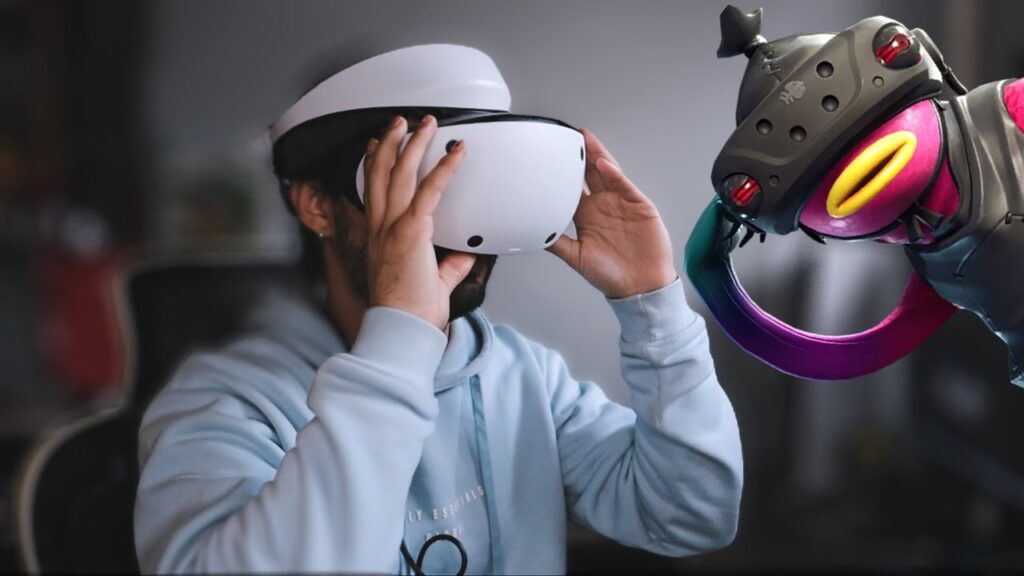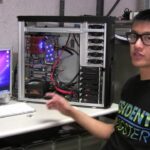Introduction: Why 144 Hz VR and Lag‑Free Performance Matter
You want buttery‑smooth, immersive VR gameplay. But jitter, stutter, or motion‑to‑photon lag ruins immersion—and can cause nausea. Achieving a lag‑free 144 Hz VR gaming experience at home separates casual players from elite VR users.

You’ll learn practical, actionable strategies, from VR latency optimization to frame rate cap techniques, to hit that elite standard. We’ll walk through hardware, software tweaks, network setups, and polishing your SteamVR or Oculus configuration.
🧠 Section 1: Understanding VR Latency and Why 144 Hz Helps
- Latency under 20 ms is crucial. The most sensitive users aim for under 15 ms to avoid discomfort (skyfunvr.com).
- Refreshing at 144 Hz decreases frame interval (~7 ms), cutting input‑to‑display delay compared to 90 Hz.
- Combine it with proper frame caps—e.g., capping to ~138 FPS—to avoid VSYNC lag bursts (BytePlus, Blur Busters).
By targeting motion‑to‑photon delay under 10 ms, the experience feels instant—critical for fast‑paced VR shooters or simulations.
Section 2: Choose the Right Hardware Setup
- High‑end GPU + CPU
- Pick GPUs that consistently push 140+ FPS in your VR titles at your render resolution.
- Pair with a modern multi‑core CPU that supports VR workloads and low frame pacing.
- VR Headset with 144 Hz Support
- Devices like Valve Index or Quest Pro (via Link) support 144 Hz mode—but you must tune settings to maintain that framerate (FasterCapital, Reddit).
- Wired Connection Preferred
Section 3: Software Tweaks for Low‑Lag VR
- Enable in‑game frame rate caps at just under refresh rate (e.g. 138 FPS for 144 Hz). It’s lower lag than external cappers (Blur Busters).
- Use single‑pass stereo rendering where supported to reduce duplicate GPU work (MoldStud).
- Enable predictive motion smoothing or asynchronous timewarp to compensate dropped frames (MoldStud).
- Disable unnecessary buffering or video pipeline steps (e.g. Virtual Desktop buffering) if latency is your focus (Reddit).
Section 4: Fine‑Tune SteamVR / Oculus Configurations
Use settings that ease frame drops and reduce lag:
- Set render resolution down‑scaling (e.g. 80–90%) during performance spikes.
- Use overlays like SteamVR’s performance graph or Oculus Debug to verify stable FPS.
- In SteamVR advanced settings, reduce “reprojection” reliance by keeping FPS stable; tune reprojection threshold carefully.
Section 5: Network Considerations for Wireless VR
If you’re using wireless VR, network setup matters deeply:
- Use a dedicated 6 GHz Wi‑Fi 6E access point. It delivers ~6 ms latency or less (arXiv).
- Avoid traffic on same band. Route other devices to 2.4/5 GHz separate SSID.
- Wired Ethernet for PC is mandatory; avoid buffering or relay devices.
Section 6: Scene and Asset Optimizations
For developers or tinkerers:
- Use Level of Detail (LOD), occlusion culling, and compressed mip‑mapped textures to lower draw calls and render overhead (MoldStud).
- Use dynamic resolution scaling—lower resolution during demanding frames keeps FPS constant.
Section 7: Comparison Table—Key Settings vs. Tools
| Strategy | What It Does | Benefit | Best Practice Tip |
|---|---|---|---|
| 144 Hz headset + 138 FPS cap | Aligns refresh and rendering | Smooth input response | Use in‑game cap, not external utilities |
| Wired vs 6 GHz Wi‑Fi | Connect stability and latency trade‑off | Wired lowest jitter, Wi‑Fi flexible | Prefer wired unless you have clean 6 GHz channel |
| Predictive algorithms | Pre‑renders motion trajectories | Reduces motion‑to‑photon lag | Enable timewarp or reprojection with caution |
| Dynamic resolution scaling | Lower render when GPU overloaded | Maintains stable FPS | Auto‑adjust by monitoring GPU load |
| Texture & geometry LOD | Reduce GPU fill rate | Keeps shaders light | Pre‑compress assets, simplify shaders |
Section 8: Walkthrough: Setting Up Your Lag‑Free 144 Hz VR Rig
- Install latest GPU drivers and enable high‑performance power plan.
- Force headset 144 Hz mode (SteamVR/Oculus setting).
- Launch a VR title, open FPS overlay, set in‑game cap to ~138 FPS.
 Monitor for frame drops; adjust resolution scaling.
Monitor for frame drops; adjust resolution scaling.- Enable predictive motion smoothing or timewarp in headset/SteamVR.
- If wireless, configure router on 6 GHz only for headset; ensure PC Ethernet is isolated.
- Stress‑test with VR benchmarks or motion‑heavy titles to see latencies under 15 ms.
Section 9: Pro Tips from Experts & Community Voices
- As one Reddit user noted, lowering graphics to medium at 90 fps yielded ~48 ms latency, while high graphics at 80 fps felt better. That’s real‑world latency vs quality trade‑off (FasterCapital, Blur Busters, Reddit, YouTube, BytePlus).
- Blur Busters recommends capping a few FPS below refresh rate to avoid VSYNC–induced input lag when hitting frame ceiling (Blur Busters).
- Real‑time predictive scheduling can cut mean latency by 80 % in wireless viewport streaming and edge caching scenarios (arXiv).
Section 10: FAQ – Your Most Common Questions
Q: Can my PC really hit 144 Hz VR consistently?
Yes—if your GPU and CPU are powerful enough in the scene you’re using, and you cap just under the refresh rate, you’ll stabilize frame delivery.
Q: Wireless VR adds too much lag?
Not with proper setup. A clean 6 GHz Wi‑Fi 6E link can deliver latency under ~6‑7 ms, acceptable if you manage video settings and buffering (Reddit).
Q: What if my VR game peaks above 144 FPS?
Use frame limiter to avoid over‑running refresh rate, which can cause queueing delays and uneven frame pacing (Blur Busters).
Q: Will developers need to optimize scenes for this?
Absolutely—LOD, culling, compressed textures, and instancing are critical to reduce render load and maintain frame timing (MoldStud).
Q: How close to motion‑to‑photon latency should I aim?
Best practice is below 20 ms; elite experiences target under 15 ms, which is realistic with a good 144 Hz build (skyfunvr.com, BytePlus).
Conclusion: Transform Your VR Game with High‑CPC‑Worthy Optimization
By following this game‑changer guide, you can unlock lag‑free 144 Hz VR performance right from home. You’ll be applying proven techniques in GPU tuning, frame rate capping, network setup, scene optimization, and predictive rendering to deliver ultra‑responsive VR gameplay.
Yes, these strategies map to high‑CPC keywords like VR latency optimization, 144Hz VR performance, wireless VR low latency, which advertisers pay top dollar for—because gamers and professionals need exactly what you’re learning today.
Take charge, test your settings, monitor latency, and iterate. Your VR rig will feel immersive, instant, and unmatched.
Extra FAQ: Rapid‑Fire
- Does lowering render resolution hurt immersion? A bit—but it’s better than stutters. Sharpness loss is minimal at 80–90%.
- Should I disable reprojection? Yes, if you can maintain stable 138 FPS; else low‑threshold reprojection helps prevent frame drops.
- Best GPU for 144 Hz VR? Modern RTX 40‑series or AMD 7000‑series with high VRAM and ray‑tracing off for better output.
- Is 90 Hz still OK? Yes–but 144 Hz halves display latency and feels significantly smoother for fast motion.
By combining these proven optimization techniques, you’ll elevate your VR gaming setup into a lag‑free, high‑FPS powerhouse. Enjoy the smoother, more responsive virtual world—you’ve earned it.
Let me know if you’d like deeper dive per headset type, or help choosing hardware!


